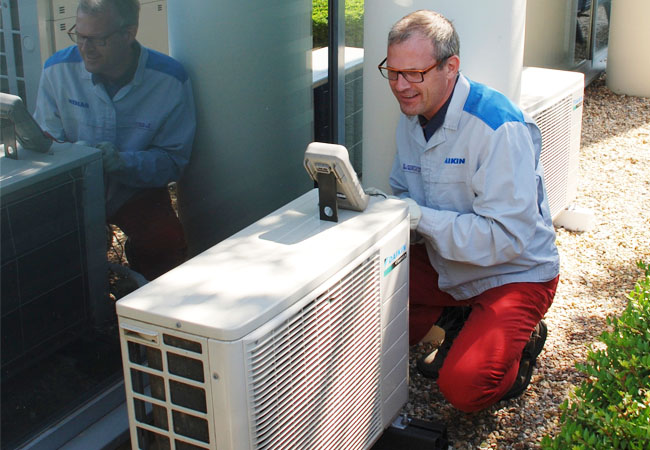
Changes to installation, commissioning and servicing procedures brought about by the switch to lower-GWP refrigerants have been a significant concern for the industry since the introduction of the F-Gas Regulation
A prime reason for Daikin favouring R32 as a replacement for R410A is that the effect on installation procedures is relatively minor, because R32 has similar properties to R410A and makes up 50% of R410A.
In essence, installation, the pipework (ability to use flared connections) and pressure testing and leak testing are the same. Of course, different tooling is needed, such as gauges, manifolds, leak detectors and recovery machines, but these are readily available.
However, most lower-GWP refrigerants have a designation category of A2L, a ‘lower flammable’ class. This means that the charging and recovery procedures are largely unchanged but greater awareness of the properties of a lower-flammable refrigerant are needed to minimise risk, although this does not present a major challenge.
For example, an R32 system must be ventilated during charging and recovery to prevent a build-up of refrigerant, which could be ignited by a naked flame, such as during the brazing process.
A simple risk assessment would suggest that these activities should not be carried out at the same time. Ordinarily, this is not an issue, but if an outdoor unit is being installed inside a building, then a suitably rated fan should be used to ventilate the area. Note, this is already a requirement for installing systems with R410A.
Preventing system leaks has always been of prime concern, but reducing the use of refrigerant for servicing and maintenance is even more important as the price of refrigerant increases and virgin gas supply reduces.
Lowering the amount of refrigerant needed to be used during service (and recycling gas from decommissioned units) will help reduce demand and, ultimately, the cost to the end-user. This will involve installers and service companies following best practice throughout the life of the equipment.
Offsite manufacture of piping can reduce the risk of leaks at the outset. Daikin’s Precision Piping Method, for example, uses standard and customised sections of pipework manufactured in a factory environment where preparation, bending and brazing, and testing are carried out under controlled conditions.
Sections are delivered to site, which means work on site is purely assembly, improving quality control and cutting installation time by between 20% and 30% (depending on the project). This, in turn, reduces costs and speeds up project delivery.
Leaks can be identified by careful monitoring, either on-site or remotely, to assess the tightness of the system. As cloud-based and remote solutions become more commonplace, this will make the process easier and more reliable. Additionally, the latest systems, such as Daikin’s R32 Sky Air A-series, which runs on R32, have integrated leak-check functions, reducing onsite checks and improving reliability.
Regardless of the refrigerant gas being used, the changes brought about by the F-Gas Regulation do not affect the imperative that equipment is installed and charged by competent and well-trained people. This means installers should be F-Gas certified and trained on the systems they are installing and the refrigerant gases being used.
Many manufacturers have been offering training to help installers develop their knowledge of new lower-GWP refrigerants. Daikin, for example, has trained more than 2,500 UK installers on the use of R32 since the end of 2018, providing them with essential information on installing, commissioning and servicing these systems.
- Martin Passingham is product manager for DX at Daikin UK

